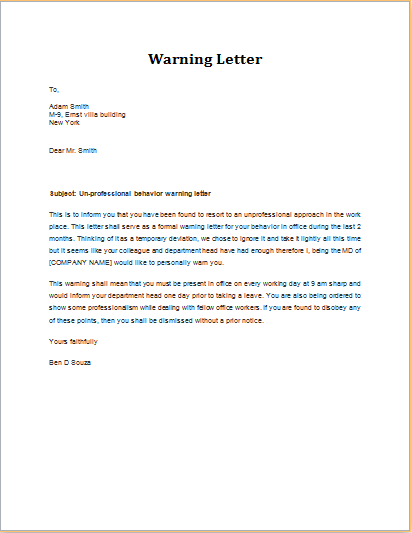Unprofessional behavior is something very annoying that people often confront in the workplace. Whenever you see someone showing unprofessional behavior, it is your responsibility to take necessary steps to stop that from happening again because sometimes, such disruptive behaviors also put the reputation of the entire organization at stake.
Behavior which is not professional is very harmful to an organization because it affects the performance of the employees in a company badly. Therefore, it is important to learn to manage such behavior. If you address the problems in the attitude of the people at the workplace earlier, you will be able to resolve many issues and concerns even before they resurface. One of the most effective ways to handle such bad behaviors is to write a warning letter to those who exhibit such attitudes.
What is a warning letter for unprofessional behavior at the workplace?
It is a letter that is a way for an employer to correct the behavior of the person who has not been acting as per the standards set by an organization. Such letters are very effective because they enable an employer to admonish the person who does not meet the expectations of the employer.
When to write the warning letter for unprofessional behavior?
There is no specific definition of what kind of behavior can be regarded as non-professional. Usually, anything which is immoral cannot be done in the office. In addition, some practices may not be in the consciousness of the employee.
For example, some companies do not allow their employees to use certain words in their speech. If the employee uses that work repeatedly, he can be issued a warning letter. Many other such situations require the employer to draft a letter to reprimand the employee who does not act following the policies of the company.
How to write?
A warning letter should always be written following best practices because it is a way of formal communication between the employee and the company. If you don’t write this letter in an efficacious way, you will not be able to reap the results of the letter. Here are some tips to follow when you have to reprimand a person due to the bad behavior he has shown:
Inform the employee about the warning:
Start the letter by asking the employee to consider your letter as a formal warning from the company because he has shown a kind of behavior that is not acceptable to the company. If you don’t tell the employee that this is a warning letter, he may not be able to understand it. Therefore, you should mention it clearly that your letter should be regarded as a warning letter.
Discuss the incident:
In most cases, employers write warning letters regarding a particular incident in which the employee’s behavior was bad. If this is the case with you also, you should give the specifics of that incident first including the date, day, time, and people involved in the incident. After that, the employer should discuss the entire incident so that the employee can realize that the employer has taken the notice of the bad behavior and now he should be wary of how he behaves.
Mention the consequences:
The warning letter does not only reprimand the employee but also lets him know that he is going to be in trouble if he repeats the same mistake. The consequences should be mentioned in such a way that the employee can easily understand that now is a time for him to change his behavior and act sensibly.
Ask the employee to cooperate:
Your warning letter should not give a message to the employee that you are being rude because you have the authority to do so. Therefore, at the end of the letter, let the employee that you want him to cooperate with you so that a healthy environment at the workplace can be developed where everyone gets an equal opportunity to grow and develop. This will enable the employee to feel sorry for his past behavior and he will be likely to improve his behavior.

File: Word (.doc) 2007/+ and iPad;
Size 23 KB
See also:
- First Warning Letter for Negligence of Duty
- Ramadan Schedule Notification for Staff
- One Day Absent Note to Boss
- Request Letter to Staff for Voluntary Deduction from Salary
- Holiday Closing Messages
- Letter Requesting Transfer to another Department
- Letter Requesting Promotion Consideration
- Umrah Leave Request Letter to Boss
- Ramadan Office Schedule Announcement Letters/Emails
- Letter to Friend Expressing Support
- Letter to Employer Requesting Mental Health Accommodation
- Letter Requesting Reference Check Information
- Letter Requesting Salary Certificate
- Letter Requesting Recommendation from Previous Employer
- One Hour Off Permission Letter to HR